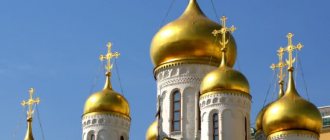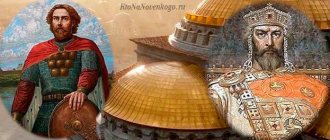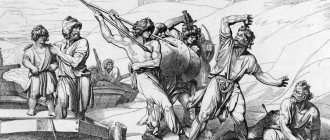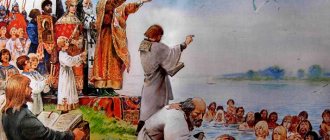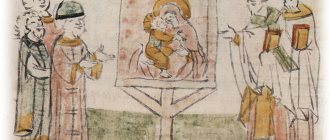The Baptism of Rus' is the adoption of Orthodox Christianity as the state religion in Rus', which occurred in the summer of 988 (according to modern chronology). The holiday “Day of the Baptism of Rus'” is July 28.
It is believed that Rus' was baptized by Prince Vladimir Svyatoslavovich.
“The Baptism of Rus'”, artist K. V. Lebedev, 20th century.
Day of the Baptism of Rus' - July 28
This holiday is celebrated precisely on July 28 because on this day the Russian Orthodox Church celebrates the day of Equal-to-the-Apostles Prince Vladimir (Vladimir the Red Sun).
It is believed that in 988 it was Prince Vladimir who made his choice in favor of Orthodoxy.
Epiphany Day of Rus': holiday traditions
On this holiday, a solemn church procession is usually held. It is customary to glorify Prince Vladimir, remember one’s baptism, and think about the meaning of God in one’s life.
On this day it is better not to drink alcohol, not to work, and try to avoid negative words and emotions.
Christianity before baptism: the first attempts of princes to baptize Rus'
The first Christians found themselves in Slavic settlements and trading posts already in the 9th century, and possibly earlier - in any case, archaeological finds of characteristic ritual artifacts in Staraya Ladoga, where the semi-legendary Rurik would arrive, date back to this century.
Fossil data correlates well with reports from written sources, according to which some “Rus” adopted Christianity in the middle - second half of the 9th century: these events are often associated with the reign of Askold and Dir in Kyiv.
Engraving by F. Bruni “The Death of Askold and Dir.” Source: Essays on events from Russian history, composed and engraved by professor of painting F. Bruni
By the 10th century, a large number of Christians lived in Kyiv and Novgorod, the largest cities of the united state created by the Prophetic Oleg. This is also confirmed by the results of archaeological excavations. Important changes in the religious composition of the population of Ancient Rus' also coincide with the key political event of that period - the adoption of Christianity by Princess Olga, the widow of Igor Rurikovich, killed by the Drevlyans.
Baptism of Princess Olga. Source: wikipedia.org
Already at this time, serious problems associated with Christianity were emerging. In 959, the German Bishop Adalbert of Magdeburg went to Rus' - this visit was the result of satisfying the request of Princess Olga addressed to the Emperor of Germany Otto I, regarding assistance in the spread of Christianity in Russian lands. However, the mission of the clerics was not successful. After some time, the bishop returned to his homeland, and some of his associates were killed by pagans - it is believed that not without the participation of Olga’s son, Svyatoslav.
New attempts to establish contacts with religious leaders of the West were recorded during the short-term reign of Yaropolk Svyatoslavich, the brother of the future baptist of Rus'. In 979, he turned to the Pope with a request to send clergy to Kiev for sermons, which managed to turn against himself not only the pagan circles of the capital, but also the Christians living in the city, who gravitated towards eastern practices of confession of faith. This short-sighted step largely predetermined the defeat of Yaropolk in the fight against Vladimir.
Yaropolk Svyatoslavich surrounded by his squad. Source: commons.wikimedia.org
The meaning of accepting Christianity
| Category of value | Content |
| Political |
|
| International |
|
| Spiritual |
|
| Moral |
|
Why Christianity?
When Vladimir began to consider what religion his subjects should adopt, he had options: Orthodoxy, Judaism, Islam or Catholicism. He sent his messengers to all countries so that they could actually see what the foundations and traditions look like in those areas where these faiths exist. What impressed the envoys most about Byzantium was their faith. And then the prince made a decision.
By that time, Bardas Phocas, who was trying to take the throne of the emperor, went to war against Constantinople. Vladimir and his army hastened to his aid and defeated the attackers, thus receiving the great favor of Emperor Vasily II.
Christianity and world religions at the turn of the 1st and 2nd millennia
In the 10th century, world religions Christianity, Islam and Buddhism determined the level of civilization of developed countries. For Rus', Buddhism was not relevant due to the remoteness of the bearers of the cultural tradition. At the same time, Judaism (conditionally a world religion) had a rather strong influence here, as a vestige of the Khazar Kaganate defeated by Prince Svyatoslav. Islam was practiced by the inhabitants of Volga Bulgaria, a culturally and economically advanced state. Christianity was the state religion of Byzantium and the European powers on the western borders of Rus'. All these religions cultivated monotheism, which was the main bond of the developed state of that era.
Reasons for adopting a new religion
The need for Russia to adopt a new faith was influenced by both internal political and external circumstances
| Inner necessity | International terms |
| The unification of all East Slavic tribes under the rule of the Kyiv prince | Strengthening cultural and socio-economic ties with the outside world |
| Justification of social stratification by divine providence | Rapprochement with Byzantium – the then center of civilization |
| Raising the authority of the Kyiv authorities | Introducing Rus' to the cultural and spiritual values of Christian Europe |
| Destruction of the remnants of the tribal system | Introduction of Kyiv into the circle of pan-European politics |
| Strong influence of the Orthodox community in Kyiv | Strengthening the international authority of Kievan Rus |
An important prerequisite that persuaded Prince Vladimir to accept Christianity of the Byzantine rite was its popularity in the upper stratum of Kyiv society (the example of Princess Olga, baptized in Constantinople).
Princess Olga and her role in the formation of Orthodoxy
In this regard, the widow of Prince Igor, a wise and far-sighted woman, visited Byzantium and was baptized there in the Orthodox faith with the name Elena. It is interesting that in order to implement her plan, Olga had to use a trick. Byzantium of that time did not really strive to correct the pagans, and did not baptize barbarians like that.
Olga promised the emperor, who was falling behind her, that if she accepted the Christian faith, she would become his wife. But on condition - only if he personally baptizes her. And then, after the sacrament was performed, she refused, claiming that she could not commit a sin by marrying her godfather.
Upon arrival home, she tried to reason with her son, Prince Svyatoslav, and persuade him to Christianity. But he, along with his retinue, was an avid pagan, and did not accept his mother’s faith. But his illegitimate son, Vladimir, was growing up. It was he, under the influence of his grandmother, and under the pressure of circumstances, demonstrating the remarkable abilities of a wise ruler, who was baptized himself and led his entire people to Christianity.
Spread of Orthodoxy in Rus'
In the rest of Rus', the transition to Orthodoxy lasted almost a century. The process proceeded slowly due to the resistance of the local population, incited by the priests of pagan cults (“magicians”, “magi”, etc.). The example of Novgorod is illustrative, where residents staged an anti-clerical uprising. The trusted governor of Vladimir, Dobrynya (probably his own uncle), set fire to the suburbs and, under the threat of murder, drove the townspeople into the Volkhov River. A similar “baptism of fire and sword” occurred in other regions of Ancient Rus'. The Russian people finally accepted the Christian religion as their own only after 250-300 years.
Baptism of Novgorod: on the threshold of civil war
Problems arose already at the first stage of the spread of Christianity - Veliky Novgorod became a center of resistance. The religious issue was closely intertwined with the political: noble people of the former capital of Rus' were wary of the will of Kyiv, seeing in baptism a possible weakening of their independence. Vladimir was also aware of the problems, so in 990 a military expedition under the leadership of Voivode Dobrynya, the uncle of the Kyiv prince, set off to the north-west of the country.
Initially, Dobrynya and clergy sent from Kyiv baptized several hundred Novgorodians who agreed to this event in order to convince the local population of the correctness of this decision. The following year, during a new campaign, the Novgorodians, led by the thousand Ugonai and the sorcerer Bogomil, decided to resist the Kievans. An uprising began, during which the pagans destroyed the house where Dobrynya was located. He decided to act quickly - it was the surprise of actions that could ensure his victory over the superior forces of the rebels.
His comrade Putyata tied up the superior forces of the Novgorodians in battle, and at this time Dobrynya himself began to burn the houses of the pagans. The fire quickly spread among the wooden houses, which forced the rebels to negotiate with the people of Kiev. At a citywide meeting, city residents allowed the construction of churches in Novgorod and promised not to interfere with Christian preachers, but a very small number of citizens wished to be baptized.
This did not suit Dobrynya - he began to carry out religious rituals by force, using his troops, and also destroyed pagan sanctuaries and temples. The people of Kiev celebrated the victory. And although many Novgorodians adopted Christianity only out of fear of the authorities - for a long time pagan gods were secretly revered in the city - nevertheless, Vladimir Svyatoslavich celebrated his victory: he managed to subjugate the second most important city of the state to his will.
Modern view of the Volkhov River, where Novgorodians were baptized. Source: wikipedia.org
The process of baptism of Russian lands dragged on for decades. In fact, only residents of large cities converted to the new faith, but their loyalty was often subject to great doubt. The border territories of the state remained pagan for a long time: for example, the Vyatichi tribe refused to convert to Christianity, according to some sources, until the 14th century.
After the baptism, the former pagan clergy and sympathizers of Perun went underground. Temples were erected throughout the country, and clerics arrived from Byzantium to train clergy from the local population. The Magi were just waiting for an opportunity to show themselves in all their glory, and such opportunities were repeatedly given to them throughout the 11th century.
Magus Fantasy of a modern artist. Source: commons.wikimedia.org
The first major uprising took place in Suzdal in 1024, when the region was struck by a terrible crop failure and drought: there was not enough food, and ordinary people tried to find the culprits of the bad weather. The Magi were near them in time: they blamed the tribal nobility for all the troubles. According to pagan traditions, the guilty were sacrificed to appease the gods. This is what the rebels did, simultaneously putting elderly people to death in order to “renew” the earth. Yaroslav the Wise did not react in any way to the speech of the residents of Suzdal - the uprising died out on its own.
The most famous pagan performances occurred 50 years after the events in Suzdal. In 1071, the people of Rostov and Novgorod rebelled, and the rebellion happened for exactly the same reasons as in Suzdal - drought, crop failure and distrust of noble people who, it seemed, were hiding food supplies. In both cases, the performances were led by Magi who emerged from underground. This suggests that the pagan faith was still deeply rooted in the people, because a little less than a hundred years passed after the baptism of Rus'.
In Novgorod, according to the Tale of Bygone Years, in 1071 a nameless sorcerer appeared on the streets of the city and began to agitate the local population against the local bishop. The chronicler reports that only Prince Gleb and his retinue remained on the side of the Christian cleric - 80 years after the city was baptized by Dobrynya, the overwhelming majority of the townspeople sympathized or at least were sympathetic to pagan cults.
Street fighting almost broke out in Novgorod, but the prince quickly stopped a possible attack by simply killing the sorcerer. It is interesting that after the death of the leader, the dissatisfied simply went home.
Andrey Ryabushkin. Prince Gleb Svyatoslavovich kills the sorcerer at the Novgorod Assembly. 1898 Source: commons.wikimedia.org
In Rostov, also against the backdrop of crop failures, in 1071 two wise men from Yaroslavl appeared and began to brand Christian clergy and the local nobility - they say that they are to blame for all the troubles that befell the common people. Having gathered a certain number of associates, the pagans began to destroy the surrounding churchyards, specifically pointing out noble women, accusing them of hiding food. Soon the rebels reached Beloozero, where Jan Vyshatich, the governor of Prince Svyatoslav Yaroslavich, was located. The rebels and Jan's detachment clashed near the city, but the battle ended in nothing.
Then the governor turned to the residents of Beloozero and demanded that they deal with the Magi on their own while his detachment collected tribute. The townspeople soon complied with the request of the princely envoy; the pagan clergy were caught, interrogated, and then handed over to the relatives of the murdered women.
Sergey Ivanov. Jan Vyshatic and the pagans. 1912 Source: commons.wikimedia.org
The Suzdal, Novgorod and Rostov events turned out to be the largest uprisings of the 11th century. However, chroniclers also reported a surge in robbery on the roads: “dashing people” became a headache for the princes at the turn of the 10th and 11th centuries. Apparently, religious changes, coupled with constant civil strife, became one of the reasons for the deterioration of the situation in the country. The Baptism of Rus' divided society for many decades.
Christianity in the 10th and 11th centuries was able to gain a foothold in the large cities of Ancient Rus', which nevertheless did not prevent local residents from periodically rebelling under the leadership of pagan priests. In rural areas and regions remote from trade routes, the situation was even more complicated. It can be reconstructed using data obtained through archaeological excavations. Artifacts discovered in the burials suggest that dual faith reigned among most of the population: Christian rituals and relics coexisted with pagan ones.
An echo of this phenomenon can be observed to this day: people celebrate Maslenitsa, celebrate carols, and jump over the fire on Midsummer Day. “Holy Rus'” was never able to completely rid itself of its pagan past.



